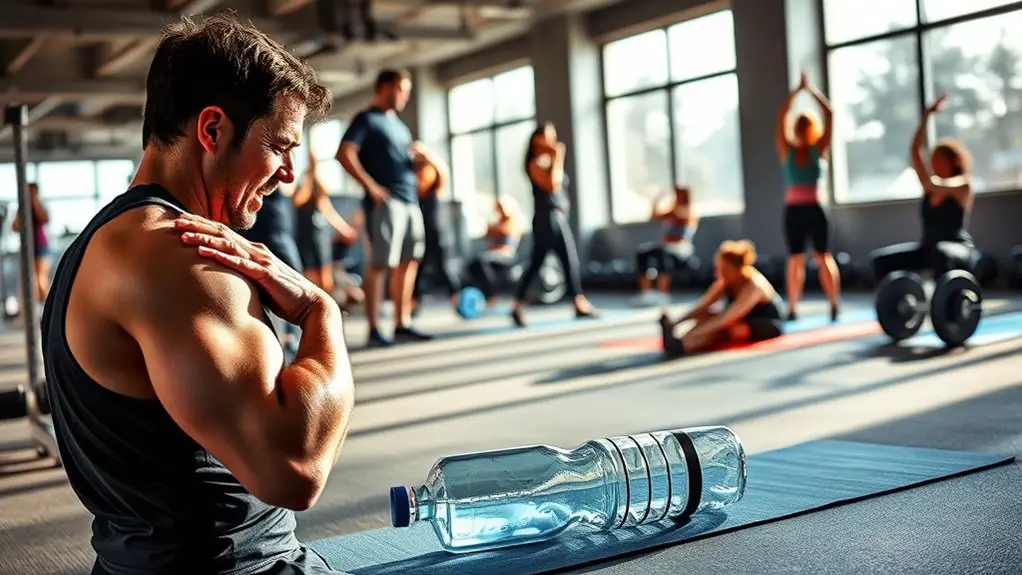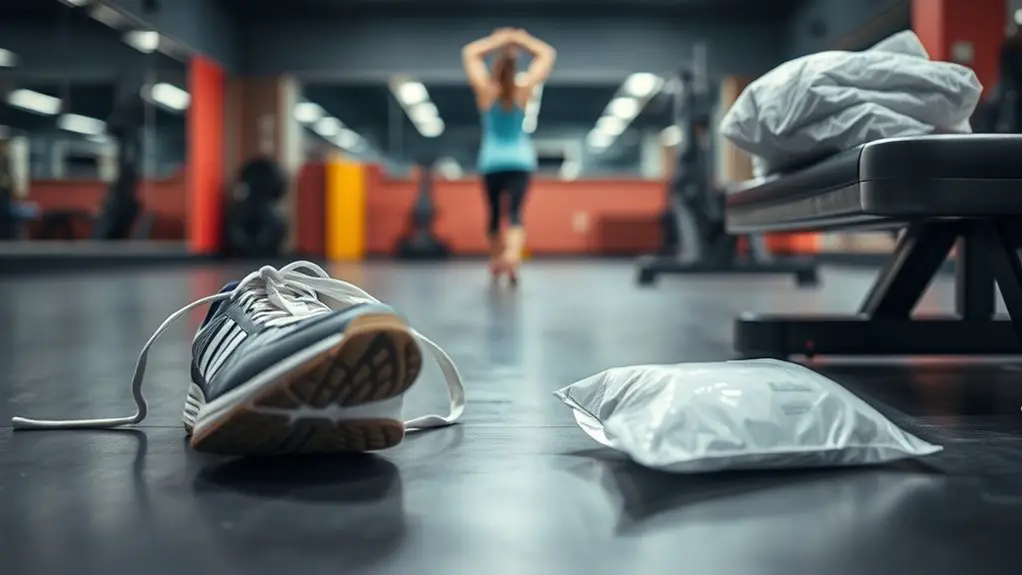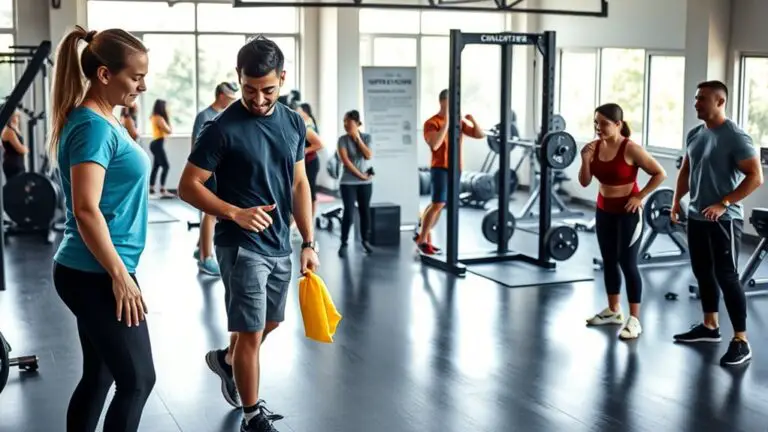Common Gym Injuries and How to Avoid Them

Common gym injuries like sprains, strains, and tendonitis often happen from improper techniques or insufficient warm-ups. To avoid them, always do dynamic stretches, stay hydrated, and gradually increase exercise intensity. Proper lifting techniques, especially for your back, shoulders, and knees, are essential. You should also pay attention to signs of fatigue and take breaks when needed. By following safety guidelines and understanding injury symptoms, you can enhance your workouts and stay injury-free. There’s more to explore about specific injuries and their prevention.
Sprains and Strains: Understanding the Risks

When you push your body to its limits at the gym, you might not realize that sprains and strains are lurking around the corner. These injuries can occur suddenly, often due to improper techniques or inadequate preparation. To reduce your risk, incorporate dynamic warm ups into your routine. These warm ups increase blood flow and flexibility, preparing your muscles for the workout ahead.
After your session, don’t skip out on recovery techniques. Stretching, foam rolling, and gentle movements can help your body recover and prevent stiffness. Listening to your body is essential; if something doesn’t feel right, take a break. Recognizing the signs of fatigue and overexertion can spare you from painful injuries. By prioritizing safety through effective warm ups and recovery practices, you’ll keep your body strong and minimize the chances of sprains and strains, allowing you to focus on reaching your fitness goals.
Tendonitis: Causes and Prevention
Tendonitis can sneak up on you, affecting your performance and causing pain in commonly used joints. It’s important to recognize the symptoms and understand the risk factors that might lead to this condition. Luckily, there are effective strategies you can use to prevent tendonitis and keep your workouts on track.
Common Symptoms Identified
One of the most common symptoms of tendonitis is persistent pain around a joint, often worsening with activity. You might also experience joint stiffness and muscle fatigue, making it challenging to perform your workouts effectively. Recognizing these symptoms early can help you take preventative measures and avoid further injury.
| Symptom | Description | Action to Take |
|---|---|---|
| Persistent Pain | Pain around a joint | Rest and ice the affected area |
| Joint Stiffness | Limited range of motion | Stretch and warm up properly |
| Muscle Fatigue | Weakness in surrounding muscles | Gradually increase intensity |
Risk Factors Explained
Understanding the risk factors for tendonitis can greatly reduce your chances of developing this common gym injury. Tendonitis often arises from repetitive movements and overuse, especially if you’re pushing your limits too quickly. Poor technique or improper equipment can exacerbate these risks. Additionally, age and pre-existing conditions can make you more susceptible. If you’re new to a workout routine or returning after a break, take it slow to allow your body to adjust. Strength imbalances and lack of flexibility can also contribute to tendonitis. By being aware of these risk factors, you can make informed choices that enhance injury prevention. Prioritize listening to your body, and don’t hesitate to seek professional advice when needed. Your long-term health depends on it!
Effective Prevention Strategies
While you might be enthusiastic to push your limits in the gym, implementing effective prevention strategies for tendonitis is vital to maintaining your performance and overall health. Start with proper warm-up routines to prepare your muscles and joints for activity. These routines can help increase blood flow and flexibility, reducing the risk of injury. Additionally, hydration strategies play an important role; staying hydrated keeps your tendons lubricated and functioning effectively.
| Prevention Strategy | Description | Importance |
|---|---|---|
| Warm-Up Routines | Dynamic stretches & light cardio | Enhances flexibility & blood flow |
| Hydration Strategies | Drink water before, during, and after workouts | Prevents tendon stiffness and injury |
| Rest and Recovery | Allow time for healing and muscle repair | Reduces overuse and strain |
Lower Back Pain: How to Protect Your Spine
When you’re at the gym, protecting your lower back should be a top priority. By using proper lifting techniques and focusing on core strength training, you can considerably reduce your risk of injury. Let’s explore how these strategies can keep your spine safe and healthy. Additionally, be mindful of activities like skipping rope, which can lead to lower back pain if proper precautions are not taken.
Proper Lifting Techniques
To prevent lower back pain during workouts, mastering proper lifting techniques is essential. Start by standing close to the weight, ensuring your feet are shoulder-width apart. When lifting, bend at your hips and knees, keeping your back straight and chest up. This helps you maintain proper form and reduces strain on your spine. As you lift, engage your core and avoid twisting your body, which can lead to injury. Always lift with your legs, not your back, and keep the load close to your body. If you’re unsure about your form, consider asking a trainer for guidance. By practicing these lifting techniques, you’ll not only protect your spine but also enhance your overall workout performance.
Core Strength Training
Building core strength is essential for protecting your spine and preventing lower back pain during workouts. A strong core provides stability, supporting your spine as you engage in various exercises. To enhance core stability, incorporate dynamic exercises like planks, bridges, and rotational movements into your routine. These exercises not only strengthen your abdominal muscles but also improve overall balance and coordination. Always focus on maintaining proper form and control during each movement. If you’re new to core training, consider starting with low-intensity exercises and gradually increasing the difficulty as your strength improves. Remember, a strong core is your best defense against lower back injuries, allowing you to train safely and effectively while enjoying your workouts.
Shoulder Injuries: Common Issues and Solutions

Shoulder injuries can be particularly frustrating, especially since they often stem from common gym activities like lifting weights or performing overhead movements. One of the main culprits is the rotator cuff, a group of muscles and tendons that stabilize your shoulder. When these muscles are overworked or improperly used, you risk strain or tears, leading to pain and reduced shoulder stability.
To avoid injuries, always warm up properly and focus on maintaining good form. If you’re lifting weights, start with lighter loads and gradually increase them as your strength improves. Incorporate shoulder-strengthening exercises that target the rotator cuff, like external rotations and band pull-aparts, into your routine. Finally, listen to your body; if you feel pain or discomfort, take a break or consult a professional. Prioritizing safety will help guarantee you can keep working out without the worry of shoulder injuries.
Knee Injuries: Recognizing Symptoms and Taking Action
Knee injuries are all too common at the gym, and recognizing the symptoms early can make a big difference in your recovery. You should be aware of the signs, like swelling or persistent pain, to take action before things worsen. Let’s explore the typical knee injuries, how to spot them, and tips for prevention and recovery. Incorporating strengthening exercises can help build the muscles surrounding the knees, providing better support and reducing the risk of injury.
Common Knee Injuries
While working out can be a great way to stay fit, it also comes with the risk of common knee injuries that can sideline you. To protect your knees, focus on knee stability techniques, such as strengthening the muscles around the joint. Incorporating exercises like squats and lunges with proper form can enhance your stability and reduce injury risks. If you do experience an injury, rehabilitation exercises are essential for recovery. Gentle stretches and strengthening routines tailored to your injury will help restore function and prevent further issues. Always listen to your body, and don’t push through pain. Prioritizing safety in your workouts will keep your knees healthy and ready for action.
Symptoms to Watch For
Recognizing the signs of a knee injury quickly can make a significant difference in your recovery. Being aware of the symptoms is key to effective symptom recognition and injury awareness. If you experience any of the following, it’s essential to pay attention:
- Persistent pain: Discomfort that doesn’t subside with rest may indicate a more serious issue.
- Swelling or stiffness: Noticeable swelling or limited range of motion can signal injury.
- Instability: If your knee feels like it might buckle or gives way during movement, seek help.
Prevention and Recovery Tips
To prevent knee injuries and promote recovery, it’s essential to incorporate a few strategic practices into your routine. Start with effective warm-up routines that prepare your muscles and joints for exercise. Dynamic stretches and light cardio can greatly reduce your risk of injury. If you do experience knee discomfort, don’t ignore it. Use appropriate rehabilitation techniques, such as physical therapy or targeted exercises, to strengthen the surrounding muscles and improve flexibility. Always listen to your body—if something feels off, rest and consult a professional. Remember, maintaining proper form during workouts and gradually increasing intensity will go a long way in safeguarding your knees. Prioritizing these practices guarantees a safer, more enjoyable gym experience.
Elbow Pain: Avoiding Overuse Injuries
When you push your limits in the gym, it’s easy to overlook the strain you put on your elbows, which can lead to painful overuse injuries. To keep your elbows healthy and avoid discomfort, you should focus on joint mobility and incorporate elbow stretches into your routine. Here are some tips to help you prevent overuse injuries:
Pushing limits in the gym can strain your elbows, so prioritize joint mobility and stretching to prevent injuries.
- Warm up properly: Always start with dynamic stretches to prepare your joints.
- Use proper form: Make certain you’re using the correct technique during exercises to minimize strain on your elbows.
- Take breaks: Allow adequate rest between workouts targeting the same muscle groups.
Muscle Tears: Signs to Watch For

Elbow injuries are just one of the concerns you might face while working out, but muscle tears can also be a significant setback. To stay safe, it’s vital to recognize the signs of a muscle tear early. Look out for sharp pain during activity, swelling, or bruising around the affected area. You might also experience muscle weakness or difficulty moving the injured limb. If you notice these symptoms, don’t push through the pain; it’s important to give your body the time it needs for muscle recovery.
Injury rehabilitation should start with rest, ice, compression, and elevation (RICE). Gradually reintroduce movement and strengthen the muscle to prevent future injuries. Always consult a healthcare professional if you suspect a tear to guarantee you’re following the right recovery protocol. Remember, prioritizing safety will keep you on track to achieving your fitness goals without unnecessary setbacks.
Fractures: Preventing Bone Injuries in the Gym
Although fractures might not be the first injury that comes to mind when you think of gym workouts, they can occur more easily than you’d expect. To minimize your risk of bone injuries, focus on enhancing your bone density and practicing safe workout habits. Here are some tips to help you stay injury-free:
Fractures can happen during workouts, so focus on bone density and safe practices to stay injury-free.
- Warm up properly: Always start with a dynamic warm-up to prepare your muscles and joints.
- Incorporate weight-bearing exercises: These exercises, such as squats and lunges, help strengthen your bones and improve overall stability.
- Use proper form: Make sure you’re using correct techniques to avoid putting unnecessary stress on your bones.
Shin Splints: Understanding and Avoiding the Pain
Shin splints, a common overuse injury among athletes and gym-goers, can cause significant discomfort and hinder your workout routine. To avoid this painful condition, it’s essential to pay attention to your body and implement preventive measures. Start by incorporating shin splint exercises, like toe raises and calf stretches, into your routine to strengthen your lower legs and improve flexibility.
Additionally, wearing proper footwear that offers adequate support can make a big difference. If you feel any discomfort, don’t push through the pain; instead, use recovery techniques such as icing your shins and allowing time for rest. Gradually increase the intensity of your workouts to let your body adapt, reducing the risk of injury. By staying mindful of your movements and taking these precautions, you can enjoy a safe and effective workout without the burden of shin splints.
Blisters and Calluses: Skin Injuries in Fitness
When you’re pushing yourself in the gym, blisters and calluses can easily develop as a result of friction and pressure on your skin. To keep your workouts safe and comfortable, consider these tips for blister prevention and callus care:
- Wear proper footwear: Choose shoes that fit well to minimize friction and provide adequate support.
- Use protective gear: Gloves can help reduce the risk of blisters on your hands during weightlifting or other activities.
- Keep your skin moisturized: Regularly applying lotion can help maintain skin elasticity and prevent calluses from becoming too thick.
If you do develop blisters, avoid popping them, as this can lead to infection. Instead, clean the area and cover it with a bandage. For calluses, regular filing can help keep them manageable. By following these tips, you can enjoy your workouts without the annoyance of painful skin injuries.
Frequently Asked Questions
What Should I Do if I Injure Myself at the Gym?
If you find yourself injured at the gym, don’t panic; it’s like hitting a bump in the road. First, stop your workout and assess the injury. Use resting techniques, like ice and elevation, to minimize swelling. Keep an eye on the pain; if it persists, seek professional advice. Remember, injury recovery takes time. Listen to your body, and give yourself the chance to heal properly before jumping back into your routine.
How Can I Tell if an Injury Is Serious?
If you’re wondering how to tell if an injury’s serious, start by using a symptoms checklist. Look for severe pain, swelling, or difficulty moving the affected area. If you experience any of these, it’s essential to conduct an injury evaluation. Keep an eye out for bruising or numbness, too. Remember, it’s always better to err on the side of caution—if you’re unsure, don’t hesitate to seek professional medical advice.
Are There Specific Warm-Up Exercises to Prevent Injuries?
Ever wonder if a few minutes of warm-up could save you from a world of hurt? Incorporating dynamic stretches and mobility drills into your routine isn’t just smart; it’s essential. Before you plunge into your workout, try leg swings, arm circles, and hip openers to enhance flexibility and circulation. You’ll prepare your muscles and joints for action, reducing the risk of injury and keeping you safe during your fitness journey.
When Is It Safe to Return to the Gym After an Injury?
When you’re considering returning to the gym after an injury, it’s essential to listen to your body. Typically, you should wait until you’ve completed your rehabilitation process and received clearance from a healthcare professional. Your recovery timeline may vary, but don’t rush it—give yourself the necessary time to heal fully. Gradually reintroducing workouts can help prevent re-injury, ensuring you stay safe and build strength effectively.
How Can I Strengthen My Body to Avoid Injuries?
Think of your body as a finely tuned instrument; harmony is key to avoiding discord. To strengthen your body and prevent injuries, focus on core stability exercises, which act like the foundation of a sturdy house. Incorporating flexibility training into your routine is essential, too, allowing your muscles to move gracefully and efficiently. With these practices, you’ll build resilience, making your body a fortress against the wear and tear of physical activity.





